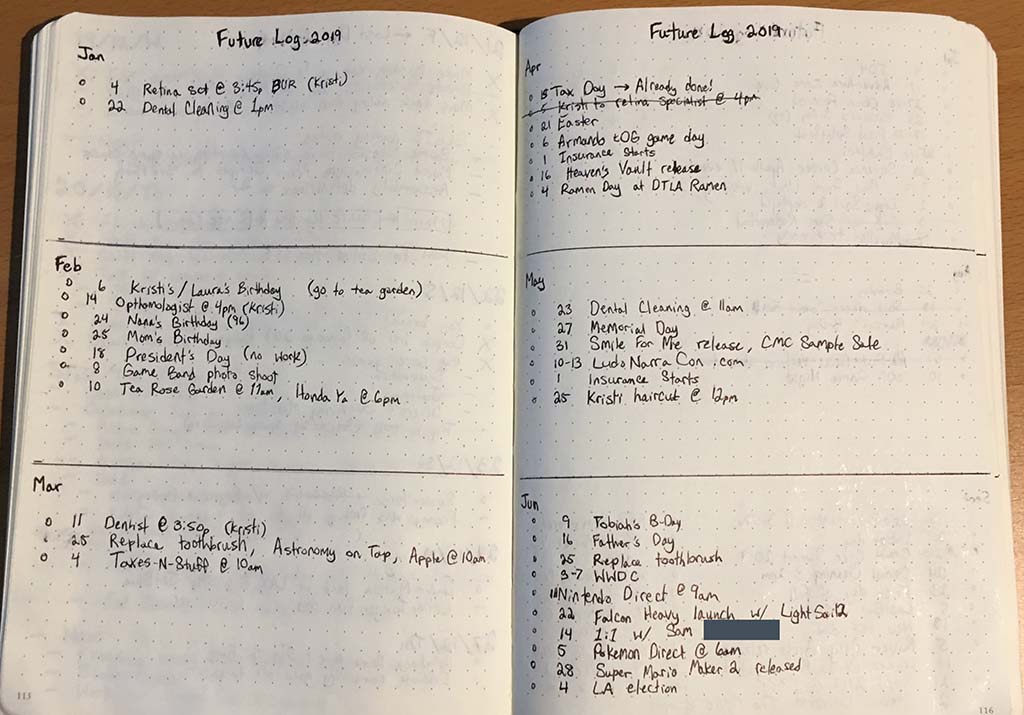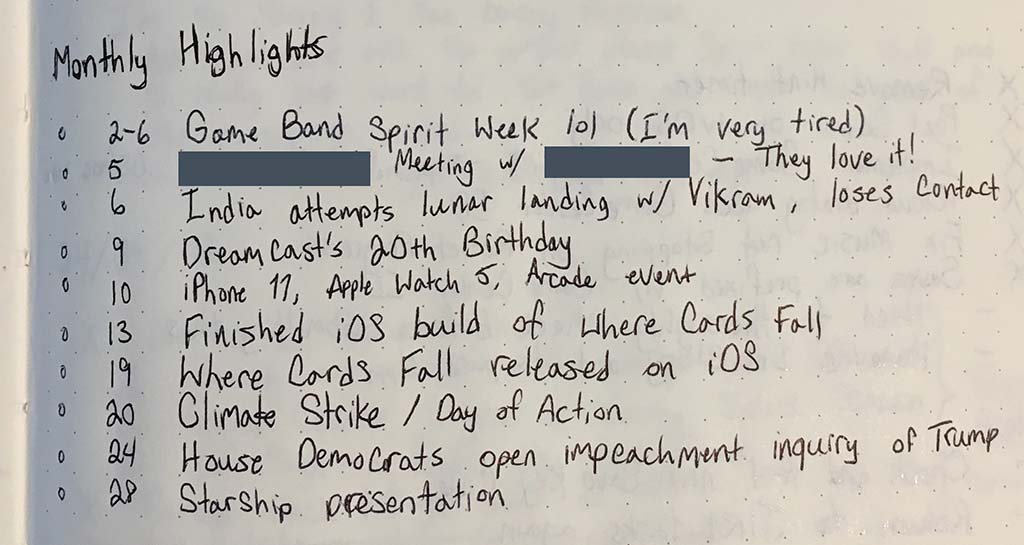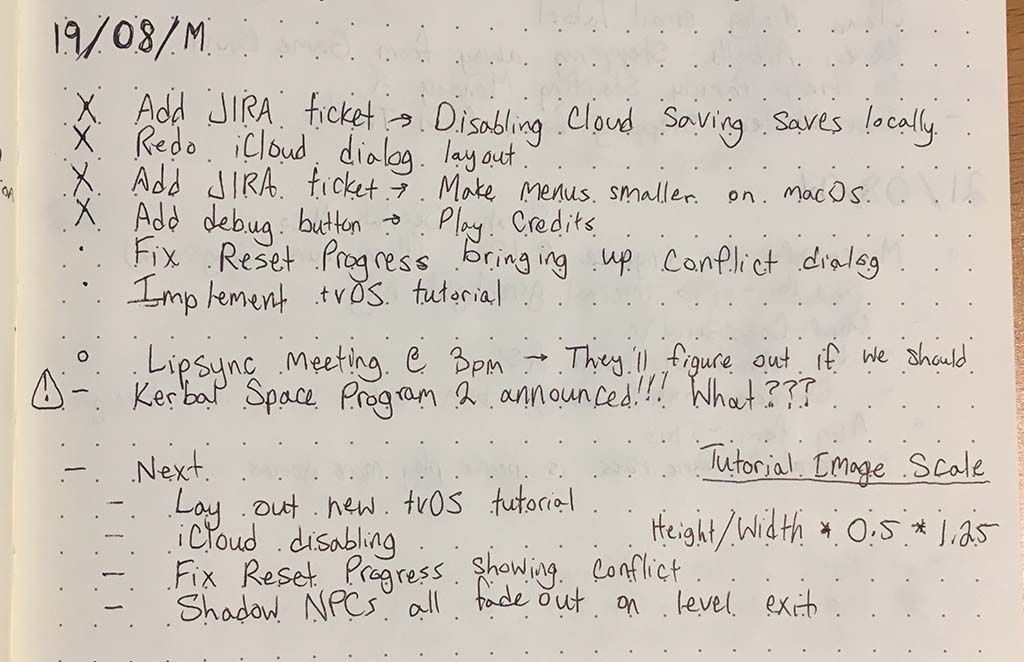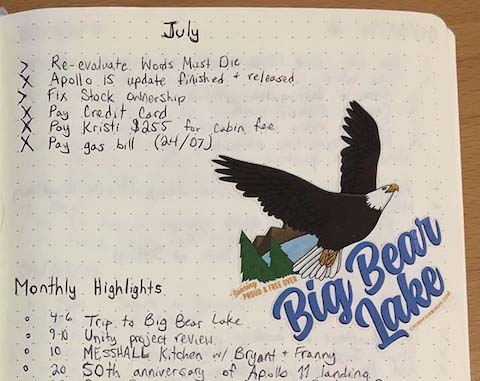I’ve always had a mediocre short-term memory, and on top of that, I can lack focus more often than I’d care to admit. Rather than deal with these shortcomings medically - which can get expensive and have other undesirable effects - I’ve tried to find aides that help me remember and keep track of things. Things I’ve tried included some off-the-shelf daily planners, calendar and to-do list apps on my phone, and just keeping a notepad by me on my desk, and nothing really stuck. They all had these drawbacks that didn’t exactly solve these problems elegantly.
Then in late 2017, I learned about the bullet journal system for use in plain, dotted journals. The structure of it intrigued me enough to give it a go.
NOTE: I won’t go over how the system works here - the original designer’s site is excellent at doing just that. I’ll assume you’ve glanced through that, and explain the ways it’s benefitted me and how I’ve applied it in my day-to-day life.
Some of the things it solves for me with its simple ruleset:
- Makes me think about what I’m going to spend my day doing
- Reminds me where I left off the previous day
- Setup reminders for upcoming days and months
- Lets me record thoughts and events of the day
- And puts all this in a central place I can revisit forwards and backwards
- Also it feels really nice to have a physical book I’m filling up
Here’s how I’ve deviated from the core guidelines with examples from my own journaling.
Index #

I have some on-going note fragments I take every now-and-then, such as having an idea for a company or game name, or one time when I was playtesting someone’s game in my off-time which ended up spanning multiple days/pages. For those, I note the pages in the index so I can easily find them again.
Future Log #

This is mostly unchanged from the base system. They recommend setting up space for 12 months on the web site, but my last journal lasted me almost 2 years. So my new journal has 36 months (12 pages) sectioned out just in case.
Monthly Log #
 **Left Side**
This is mostly the same as the base system, where each line is a day of the month, numbered, day of the week noted with a letter, and short blurb for an event or appointment. This is filled out both at the beginning of the month (from the Future Log) and filled in as new info comes up. I also added brackets showing days-long events, and note full/new moons because why not.
**Left Side**
This is mostly the same as the base system, where each line is a day of the month, numbered, day of the week noted with a letter, and short blurb for an event or appointment. This is filled out both at the beginning of the month (from the Future Log) and filled in as new info comes up. I also added brackets showing days-long events, and note full/new moons because why not.
 **Right Side**
This side is divided into two sections: goals for the month, and monthly highlights. The monthly goals are exactly like base system: a series of things to accomplish this month, and if they can’t be completed, migrated to the next month. Monthly Highlights is my own addition. It’s squarely for looking back at the month to remember what were the Big Things that happened. This is filled out as I see or realize notable things.
**Right Side**
This side is divided into two sections: goals for the month, and monthly highlights. The monthly goals are exactly like base system: a series of things to accomplish this month, and if they can’t be completed, migrated to the next month. Monthly Highlights is my own addition. It’s squarely for looking back at the month to remember what were the Big Things that happened. This is filled out as I see or realize notable things.
Daily Log #
 A page holds as many daily logs as it can. Some days have less notes than others, so sometimes (oftentimes) a page will hold 2-3 days. No need to waste half a page because I didn’t record much on a particular day before moving to the next blank page. Work days always capped off with “Next” notes, noting what I think I should work on when I get back to working next.
A page holds as many daily logs as it can. Some days have less notes than others, so sometimes (oftentimes) a page will hold 2-3 days. No need to waste half a page because I didn’t record much on a particular day before moving to the next blank page. Work days always capped off with “Next” notes, noting what I think I should work on when I get back to working next.
Minor Notes #
Stickers #

Not just for adding personality, I’ve found adding stickers from events I attended, shops I discovered, bands I saw on day/month pages where they’re relevant immediately show where in time I’ve flipped back to when looking through.
For Looking Back #
To me, the intent of every section is not only to keep track of things, but to record something notable about the day for looking back. Half the reason I find this note-taking useful is that I can use it to answer the questions “what was I doing on this particular day? What was going on?” This notebook becomes an extension of my short-term and long-term memory.
Guidelines, Not Rules #
If you’re interested in trying this kind of thing out yourself, it’s important to emphasize (as the main site does) that the system is a set of guidelines. Try it out as laid out, and change it as you go until you settle onto exactly the way things feel right to you.
